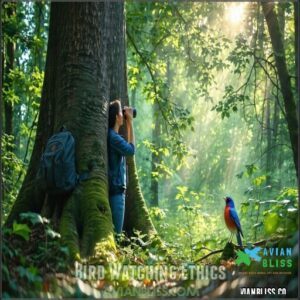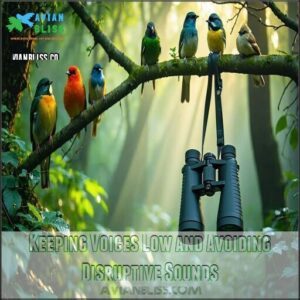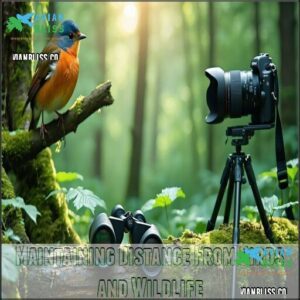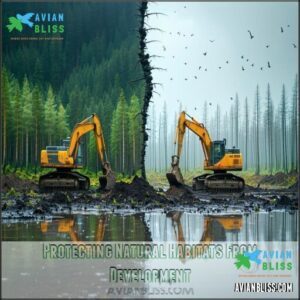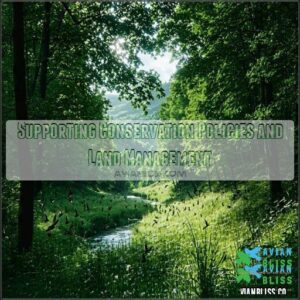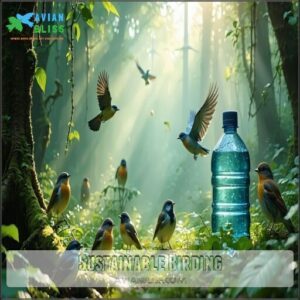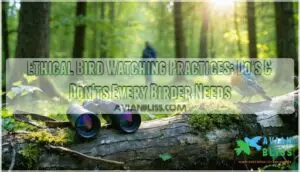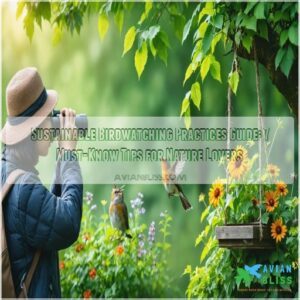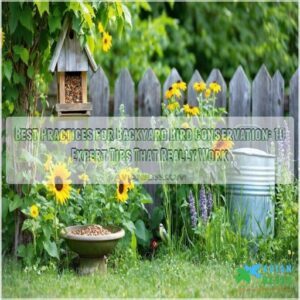This site is supported by our readers. We may earn a commission, at no cost to you, if you purchase through links.
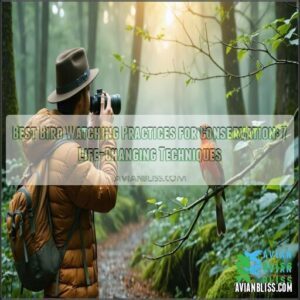
Use binoculars instead of getting too close, and wear earth-toned clothing to blend in. Record your sightings in citizen science apps like eBird to help researchers track bird populations.
The best bird watching practices for conservation include minimizing your impact by carrying out all trash and supporting habitat preservation efforts. Birds communicate stress through alarm calls—learning to recognize these signals is just the beginning of becoming a true conservation ally.
Table Of Contents
- Key Takeaways
- Bird Watching Ethics
- Conservation Practices
- Responsible Birding Techniques
- Habitat Preservation
- Sustainable Birding
- Frequently Asked Questions (FAQs)
- What are the best practices for wildlife observation?
- Why is birdwatching important?
- How can a birdwatcher contribute to conservation?
- Why should conservation enthusiasts watch wildlife?
- Why should you become a conservation-minded birder?
- What can birdwatchers do for a living?
- How to report rare bird sightings?
- When to use flash photography for documentation?
- Best birding apps for citizen science?
- How to bird watch with children?
- Conclusion
Key Takeaways
- You’ll protect birds by maintaining safe viewing distances (at least 100 feet for most species) and using binoculars or zoom lenses instead of approaching closer.
- Don’t use playback calls or pishing as these techniques waste birds’ energy, can lead to nest abandonment, and may reduce their response to real threats.
- Stay on designated trails to prevent erosion and habitat damage, and learn to recognize alarm calls that indicate you should quietly retreat from the area.
- You can support bird conservation at home by reducing your carbon footprint, preventing window strikes with decals or films, planting native vegetation, and keeping cats indoors.
Bird Watching Ethics
You’ll protect birds and their habitats when you keep a safe distance and stay on marked trails during your watching adventures.
Your quiet observation without playback calls lets birds behave naturally, reducing stress that can harm their health and breeding success.
Maintaining Safe Viewing Distances
The "rule of thumb" for maintaining safe viewing distances varies with species sensitivity and habitat type.
Keep at least 100 feet from most birds to minimize impact on their natural behavior.
Your presence can cause avian stress even when it’s not obvious.
Use binoculars or a zoom lens instead of getting closer – they’re your best friends for responsible bird watching without disturbing your feathered subjects.
Avoiding Playback Calls and Pishing
Every responsible birder knows that avoiding playback calls and pishing is essential for ethical birding. These seemingly innocent techniques can cause significant avian stress and disrupt natural behavior patterns.
Here’s why you should practice silent observation instead:
- Playback calls waste birds’ energy on defending territory
- Repeated disturbances can lead to nest abandonment
- Habituation risks reduce birds’ response to real threats
- Silent observation reveals authentic behaviors you’d otherwise miss.
Ethical birding also includes respect for habitats through bird-friendly gardening.
Recognizing Alarm Calls and Responding
While avoiding playback techniques keeps birds calm, you also need to understand their natural warning system. Recognizing alarm calls is an essential birding skill that helps protect our feathered friends.
Birds communicate danger through distinct vocalizations. When you hear these signals, it’s time to back away quietly.
When birds call out in alarm, consider it a direct request to quietly retreat from their space.
Here’s how to interpret common alarm calls:
| Bird Type | Alarm Sound | What It Means | Your Response | Environmental Impact |
|---|---|---|---|---|
| Songbirds | Rapid "chip-chip-chip" | Predator nearby | Step back slowly | Reduces avian stress |
| Jays | Harsh screeching | Ground threat detected | Leave area promptly | Protects nesting sites |
| Woodpeckers | Loud rattling call | Territory intrusion | Change your path | Minimizes disturbance |
| Warblers | High-pitched "tseet" | Aerial predator spotted | Look up, then retreat | Maintains bird safety |
| Thrushes | Low "chuck" notes | General unease | Pause and assess | Respects bird behavior |
Learning these call interpretations enhances your birding etiquette and promotes responsible habitat protection.
Staying on Designated Trails
Throughout your birding adventures, staying on designated trails is like following nature’s golden rule.
You’ll help prevent erosion and protect fragile habitats from plant trampling.
Even when that rare warbler appears off-path, resist the temptation to wander.
Responsible birding means minimizing disturbance to wildlife areas.
Trail maintenance efforts guarantee these paths remain sustainable.
Remember to Leave No Trace, so future birders can enjoy the same experiences you did.
Conservation Practices
You’ll help birds thrive by adopting simple conservation habits in your daily life, from reducing your carbon footprint to preventing window strikes.
Your small actions at home, like planting native trees and minimizing waste, create safe havens for our feathered friends who’ve seen their populations drop by 29% since 1970, which is a significant reason to focus on conservation habits.
Reducing Carbon Footprint
Many bird watchers don’t realize their carbon footprint directly impacts the very birds they love to observe.
Your birding hobby can become more sustainable when you focus on reducing energy consumption and choosing eco-friendly options.
- Carpool to birding locations or use sustainable transportation
- Stay at eco lodges or green hotels when traveling for bird watching
- Bring reusable water bottles to eliminate plastic waste
- Support renewable sources through carbon offsetting programs
Preventing Window Strikes
While reducing your carbon footprint helps birds globally, window strikes threaten them right in your backyard.
Birds can’t see glass the way we do. Apply decals or films on the exterior of windows following the 2×2 inch rule.
External screens create physical barriers against collisions. Consider installing specialized window films to prevent collisions.
For best results, combine multiple methods like bird-safe glass, proper lighting management, and smart landscaping to create a truly bird-friendly environment.
Conserving Water and Minimizing Waste
Beyond bird-safe windows lies another conservation frontier: water and waste.
Your daily choices ripple through bird habitats.
Turn off taps when brushing teeth and install rain barrels to collect precious water.
Skip single-use plastics that often end up in nests or stomachs.
Pack reusable bottles on birding trips and properly dispose of trash.
These small eco-friendly waste habits compound into powerful environmental protection.
By following these simple steps, individuals can make a significant impact on bird conservation, and it all starts with making conscious choices about water.
Planting Native Trees and Vegetation
After saving every drop of water, let’s turn your yard into a bird paradise!
Native trees and plants are like setting a five-star buffet for local birds. Your oak tree might host hundreds of caterpillars that birds love to eat.
Your backyard oak isn’t just a tree—it’s a living buffet hosting hundreds of caterpillars that birds crave.
Check Audubon’s Native Plant Database to find what works in your region. Native trees attract birds by providing food and shelter.
Your bird-friendly garden creates essential habitat restoration while supporting the entire local ecosystem.
Responsible Birding Techniques
You’ll make a real difference for birds when you practice responsible birding techniques like staying on trails and keeping your distance.
Your small, thoughtful actions during bird watching help protect habitats and reduce stress on the very creatures you’ve come to admire, which is crucial for their well-being and preserve habitats.
Keeping Voices Low and Avoiding Disruptive Sounds
While you’re taking steps to reduce your carbon footprint, don’t forget that sound matters too.
Speak softly when birding – birds have exceptional hearing and can detect your whispers from surprising distances.
Keep electronic devices silenced, and your phone on vibrate. This audio responsibility minimizes disturbance to natural bird communication patterns.
When everyone practices quiet observation, you’ll witness authentic bird behavior instead of startled reactions to noise pollution.
Avoiding Disturbance of Nests and Invasive Species
While keeping quiet during observations, you’ll also need to protect birds’ homes.
Stay away from nesting sites during breeding season – disturbed parents might abandon eggs or chicks. Watch for warning calls or "broken wing" displays that signal you’re too close.
To minimize stress, Maintain safe distances and remove invasive species when possible as they destroy habitats and outcompete native birds.
Before entering new areas, check your gear for hitchhiking seeds that could spread harmful plants, and consider the impact of your actions on native birds and their breeding season, as well as the importance of safe distances and avoiding invasive species.
Maintaining Distance From Birds and Wildlife
Bird-watching boundaries are essential for wildlife welfare.
You’ll need to maintain safe distances—about 50-100 feet for most birds—to avoid causing stress or disrupting natural behaviors.
Your responsible birdwatching approach minimizes habitat impact, especially during sensitive nesting periods.
Remember, binoculars and zoom lenses exist for a reason, and respect wildlife by keeping your distance, and you’ll be rewarded with authentic bird behaviors to observe.
Observing for Stress Signals and Backing Up
Now that you’re keeping your distance, learn to read avian body language.
Birds show stress through rapid head turns, wing fluttering, or freezing in place. If you notice these signals, back up immediately—it’s your cue to increase distance.
This simple stress mitigation technique guarantees your bird behavior analysis doesn’t harm the subjects you admire.
Remember, responsible birdwatching means putting the birds’ comfort above your perfect photo opportunity.
Habitat Preservation
You’ll make a real difference for birds when you help protect the places they call home, from dense forests to open wetlands.
Your actions to preserve natural habitats, like supporting conservation areas and creating bird-friendly spaces in your yard, directly combat the 29% population decline North American birds have faced since 1970, which is a significant issue that affects their well-being and survival, and by doing so, you are helping to protect the birds.
Protecting Natural Habitats From Development
Increasingly, natural bird habitats face threats from expanding development projects.
You can help by supporting land use planning that prioritizes green infrastructure and habitat protection. Watch for local zoning meetings where you can speak up against habitat fragmentation.
Consider donating to organizations that secure conservation easements. Remember, every protected acre matters – sustainable development isn’t just good for birds, it’s essential for their survival.
Installing native trees and shrubs provides essential food and shelter, which is crucial for bird habitat preservation.
Supporting Conservation Policies and Land Management
Beyond preserving local habitats, you can make a bigger conservation impact through policy advocacy. Getting involved in land management decisions helps protect the spaces birds need to thrive.
Here are 5 powerful ways to support conservation policies:
- Join a local land trust
- Contact legislators about the Farm Bill
- Support the Great American Outdoors Act
- Advocate for the Conservation and Landscape Health Rule
- Attend public meetings about land management decisions
Providing Water Sources and Reducing Pesticide Use
You should regularly provide fresh water sources while embracing pesticide alternatives in your bird-friendly environment.
Clean birdbaths prevent disease transmission, while IPM strategies help maintain healthy habitats.
To keep bird baths sanitary, consider using suitable cleaning products.
"I switched to natural pest control and suddenly my garden buzzed with native insects," shares avid birder Maria. "My feathered visitors doubled!"
Conservation starts with small choices that create safe havens birds desperately need.
Making Windows Safer for Birds
While providing water is essential for birds, your windows might be invisible killers.
You can make them safer with simple decal placement on the outside surface, following the "2×4 rule" – patterns spaced 2 inches horizontally or 4 inches vertically.
External screens, bird-safe glass, and reflection reduction all create a birdfriendly environment.
Remember to minimize light pollution during migration seasons too.
Sustainable Birding
You’ll help birds thrive when you make small changes like keeping cats inside and turning off extra lights at night.
Your eco-friendly choices, from reducing plastic use to supporting clean energy, create a healthier world where both you and your feathered friends can enjoy nature for generations to come, which is a great way to support clean energy.
Reducing Light Pollution and Addressing Cat Predation
While protecting natural habitats provides birds with homes, your actions at home matter too.
Bright nighttime lighting confuses migrating birds, leading to fatal collisions. Install light shielding on outdoor fixtures and dim or turn off unnecessary lights during peak migration seasons.
Keep your cats indoor pets—they’re natural hunters who kill billions of birds annually. If your cat goes outdoors, add collar bells to warn birds of their approach.
Consider supporting programs addressing feral colonies for better bird conservation. This action, along with the others, can significantly impact the well-being of birds, making peak migration seasons safer for them.
Minimizing Plastic Consumption and Waste
Plastic pollution poses a deadly threat to birds that mistake it for food or nesting material.
You can make a difference by bringing reusable water bottles and containers on birding trips.
Swap single-use alternatives for durable gear, recycle plastics properly, and participate in cleanup events.
Even microplastic impacts can harm birds, so reducing packaging helps protect the feathered friends you love to watch.
Supporting Sustainable Practices and Renewable Energy
Beyond cutting back on plastic, your energy choices directly impact the birds you love to watch. Every watt saved helps protect their habitats.
Here’s how you can make a difference:
- Invest in home solar panels or community renewable programs
- Switch to LED bulbs and energy-efficient appliances
- Support green investments through bird-friendly financial portfolios
- Join groups advocating for renewable energy policies
These sustainable practices create ripple effects for habitat protection far beyond your backyard.
Promoting Eco-Friendly Birding Practices and Community Engagement
Your support for clean energy extends beyond personal choices.
Join citizen science projects like eBird to help track bird populations. Partner with local conservation groups for community cleanups and attend educational workshops to learn sustainable birding ethics.
Make birding accessible to all by sharing your knowledge and equipment. Small actions create ripple effects—your enthusiasm for ecofriendly birding practices can inspire an entire community to protect our feathered friends.
To minimize disturbance, remember to respect bird distance during observation, and consider the importance of respect in your interactions with nature.
Frequently Asked Questions (FAQs)
What are the best practices for wildlife observation?
Like a mindful hiker on a misty trail, maintain distance from wildlife using binoculars.
Stay on marked paths, keep quiet, avoid flash photography, and back away if animals show stress signals.
Why is birdwatching important?
Birdwatching connects you to nature while supporting conservation efforts.
You’ll develop awareness of ecosystems, contribute valuable data through citizen science, and gain appreciation for wildlife that motivates environmental stewardship in your community, which is crucial for conservation efforts.
How can a birdwatcher contribute to conservation?
You’d think watching birds is just for fun, but you’re actually helping!
Plant native species, create backyard habitats, report sightings, stay on trails, and reduce your carbon footprint to protect feathered friends.
These actions contribute to a larger effort to conserve and support bird populations.
Why should conservation enthusiasts watch wildlife?
You’ll deepen your connection to nature while helping protect vulnerable species. When you observe wildlife ethically, you’re collecting valuable data and developing the passion needed to advocate for their habitats.
Why should you become a conservation-minded birder?
You’ll protect habitats, preserve species, and promote ecological balance when you become a conservation-minded birder.
Your careful observations help scientists track population trends while you enjoy nature’s symphony without disturbing its performers.
What can birdwatchers do for a living?
You can pursue careers as an ornithologist, tour guide, wildlife photographer, conservation biologist, park ranger, nature writer, environmental educator, or ecotourism operator.
Each role lets you contribute to bird conservation while earning a living.
How to report rare bird sightings?
Spotted a rare feathered friend? Report your sighting to eBird, local bird clubs, or Audubon chapters. Include clear photos, location details, and observation time. Don’t share sensitive nesting sites publicly.
When to use flash photography for documentation?
You should never use flash photography for bird documentation.
It can stress birds, disrupt their behavior, and harm nesting activities.
Instead, use natural light and adjust your camera settings for better low-light shots.
Best birding apps for citizen science?
eBird, Merlin, and iNaturalist are your best options for contributing to citizen science. You’ll help researchers track bird populations while improving your identification skills with these user-friendly apps.
How to bird watch with children?
Like tiny explorers on a treasure hunt, children thrive with bird watching.
Keep sessions short, use simple binoculars, focus on colorful species, and let them record findings.
Don’t forget snacks and breaks.
Conclusion
Have you ever wondered how small actions can make a huge difference?
By adopting these best bird watching practices for conservation, you’re not just enjoying a hobby—you’re becoming a guardian of our feathered friends.
Keep your distance, reduce your impact, and recognize when birds need space.
Your mindful approach helps protect important habitats and guarantees future generations can experience the wonder of birds in their natural environments, which is a truly huge difference.

